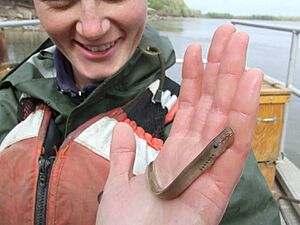Chestnut lamprey facts for kids
Quick facts for kids Chestnut lamprey |
|
|---|---|
 |
|
| Young chestnut lamprey found in Missouri | |
| Scientific classification | |
| Synonyms | |
|
The chestnut lamprey (scientific name: Ichthyomyzon castaneus) is a special kind of lamprey. It's a fish that looks a bit like an eel. These interesting creatures live in rivers and lakes across parts of North America.
Contents
What is a Chestnut Lamprey?
The chestnut lamprey is a fascinating fish known for its unique appearance and life cycle. Unlike most fish, it doesn't have jaws. Instead, it has a round, suction-cup-like mouth filled with many teeth.
How Does it Look?
The chestnut lamprey can grow up to about 38 centimeters (15 inches) long. Its body is usually tan or yellowish-olive on top. The sides, belly, and fins are lighter in color. After they lay their eggs, they turn a blue-black color.
Their mouth is very wide, even wider than their head. It has many strong, thin teeth. There are usually 4 teeth on each side of the inner row, with 6 to 11 sharp points in front. They also have 2 or 3 teeth at the very front of their mouth. This lamprey has a long fin on its back, called a dorsal fin. It does not have any paired fins, like the ones you see on most fish.
Its Amazing Life Journey
The life of a chestnut lamprey starts as a tiny egg. At this stage, the eggs can be eaten by other fish. This helps to keep the number of lampreys in balance.
Once the egg hatches, it becomes a larva. These young lampreys live in calm areas like pools or backwater spots. They prefer places with sandy or muddy bottoms. For about five to seven years, these young lampreys filter tiny bits of food from the water.
When they are big enough, they attach themselves to a host fish. Chestnut lampreys usually mate when they are about seven to nine years old. They travel to smaller streams, called tributaries, to lay their eggs. This helps protect their young from predators. Most mating happens in mid-June.
During mating, a female lamprey starts by moving small rocks to create a good spot for her eggs. Then, she attaches herself to a rock. Males will attach to her and stroke her tail, trying to mate. After the eggs are laid, they are covered with rocks. This might help shade the young and keep predators away. Like most lampreys, the chestnut lamprey only mates once in its life. It dies shortly after laying its eggs.
Who Are Its Relatives?
The chestnut lamprey has a close relative called the southern brook lamprey. This relative does not feed on other fish. Scientists sometimes call them a "paired species" because they are so similar.
Other lampreys that are related and also feed on other fish include the Ichthyomyzon bdellium, I. greeleyi, and I. unicuspis.
Where Does it Live?
The chestnut lamprey can be found in many places. Its range stretches from Lake Winnipeg and the Hudson Bay all the way down the Mississippi River. This includes parts of the Central and Eastern United States. They live in large lakes or reservoirs where there are big host fish for them to feed on.
In Canada, chestnut lampreys have been found in Saskatchewan, Manitoba, Ontario, and Quebec. Young lampreys, or larvae, are often found in calm pools and backwater areas. They like places with sand or sandy mud at the bottom.
How Does it Live?
Adult chestnut lampreys are parasitic. This means they feed on other fish. They attach to the side of a fish using their suctorial (suction-cup-like) mouths. Then, they use their teeth to make a small wound and get body fluids from the host fish.
People used to think these lampreys didn't feed in winter. However, recent studies in Wisconsin showed that some lampreys stay attached to their host fish even in winter. One fisherman even caught a sturgeon with a chestnut lamprey still attached!
Observations show that these lampreys are mostly active at night. During the day, they look for shady spots to hide. Chestnut lampreys can actually be helpful to rivers and lakes. They help control the populations of other fish naturally.
However, people can sometimes harm these animals. Pollution, siltation (when mud and sand build up), and dredging (removing mud from the bottom) can threaten them. Young lampreys, who filter feed for many years, are very sensitive to changes in their environment. For example, if large particles often block their mouths, they can starve.

